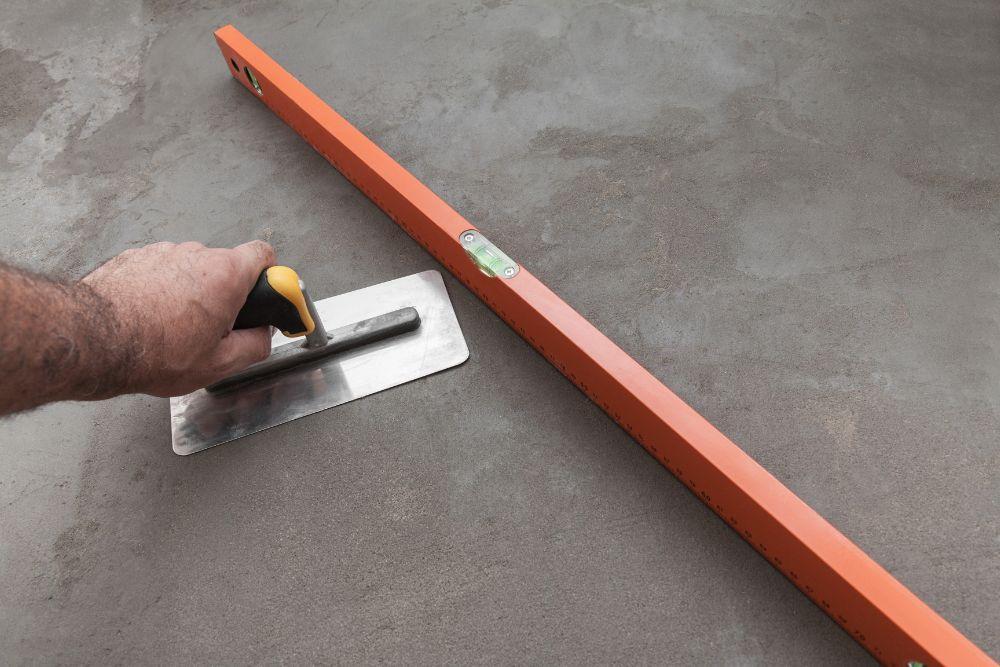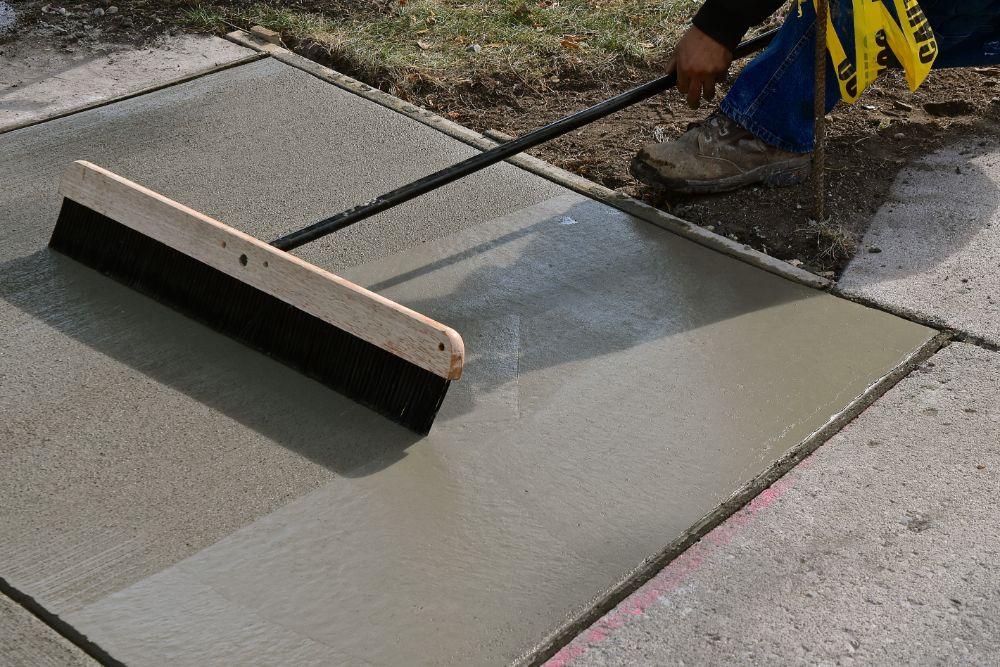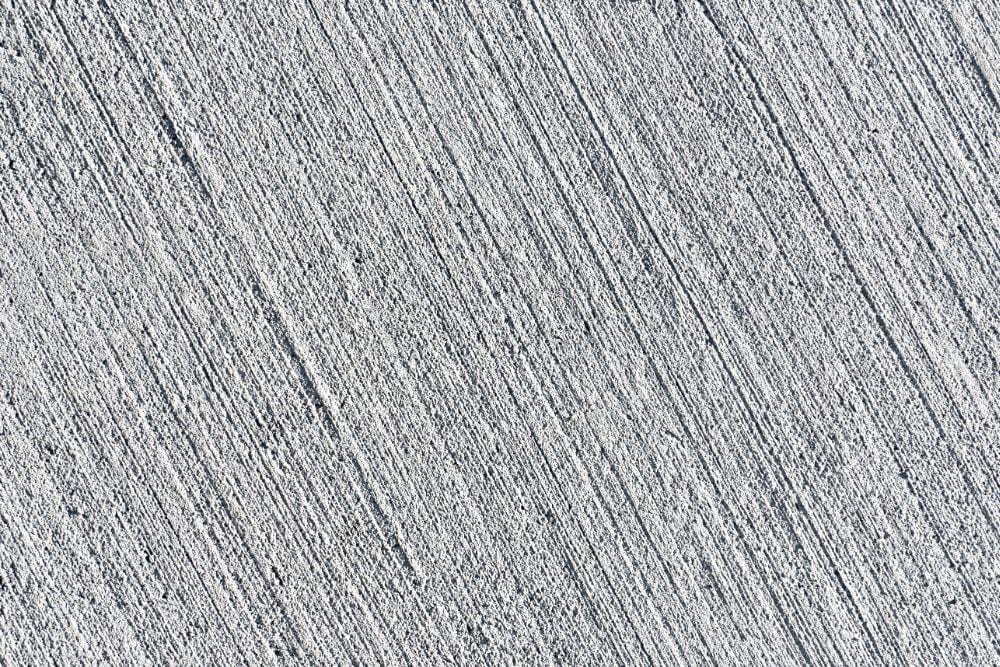A Guide to This Exterior Concrete Technique
While we don’t work on exterior surfaces that are exposed to the elements, we get asked a lot of questions about concrete. One of those questions is “What is broom finish concrete?”.
While we don’t provide this as a service, we thought it would be useful for our readers to understand what broom finish concrete is.
Broom finish concrete is a technique used to create slip-resistant surfaces on freshly poured concrete. This method involves dragging a broom or similar tool with coarse bristles across the wet concrete, creating small ridges that improve traction and prevent slipping.
Broom finishes are popular for exterior concrete applications, such as walkways, patios, and driveways, where safety is paramount and a textured concrete surface can be visually appealing.
The process of creating broom finish concrete involves preparing the surface by troweling, followed by dragging a broom over the freshly troweled surface to create the desired broom texture. Different types of brooms and tools may be used, depending on the specific requirements of the project. In addition to its functional benefits, broom finish concrete offers a variety of decorative options, including colors, patterns, and customization.
Key Takeaways
- A Broom concrete finish is a slip-resistant brushed concrete surface created by dragging a broom across wet concrete
- This method is popular for exterior applications your outside walkway, patio, or driveway
- Decorative options include colors, patterns, and customization.
Understanding Broom Finish Concrete
To achieve a broom finish, you need to wait until the concrete has reached a certain stage of setting, at which point it can hold the texture without losing its shape. Then, a specialized broom or brush is used to create small ridges and grooves by dragging it across the surface of the concrete. This results in improved traction and a slip-resistant texture, making it a popular choice for various applications such as sidewalks, driveways, ramps, and pool decks.
There are several types of broom finishes, with varying degrees of roughness. According to the American Concrete Institute (ACI), there are three main categories of broomed finishes based on groove depths: fine-broomed finish (less than 1/32 in.), medium-broomed finish, and heavy-broomed finish. The type you choose will depend on your intended use and desired aesthetic.
One advantage of broom finished concrete is its relatively simple and low-cost installation process. Since it does not require the use of additional decorative materials or labor-intensive techniques, you can enjoy an attractive, slip-resistant surface without incurring excessive costs. Furthermore, broom finished concrete is also low-maintenance and long-lasting, ensuring your investment will serve you well for years to come.
Process of Creating Broom Finish Concrete
To create a broom finish concrete surface, you’ll first need to prepare the concrete mixture. Once your concrete is ready, follow these steps to achieve a slip-resistant and textured surface for your project.

Surface Preparation for a Broom Finish Involves Screeding and Troweling the Concrete Surface
- Screed the concrete: After pouring the concrete, use a screed to level it out. Glide the screed back and forth across the surface in a sawing motion to create an even surface.
- Allow the concrete to set: Once the concrete has been screeded, let it set for a while before proceeding to the next step. The exact duration will depend on various factors such as weather conditions and the type of concrete used. During this time, be cautious as timing is critical for creating a well-finished surface.
- Trowel the surface: When the concrete is firm enough, use a trowel to smooth the surface further. Troweling helps to close up any pores and bring some of the cement to the surface, creating a denser, stronger surface. Be careful not to trowel too much, as overworking the concrete can weaken its surface.
- Apply the broom finish: As the concrete begins to harden, take a damp concrete broom and lightly drag it across the surface. This action creates a uniform pattern of ridges that will increase traction and reduce slip potential. The type of broom and its bristles will have a direct impact on the final appearance, so choose one according to your desired texture.
- Final touches: Inspect your broom finish concrete for any uneven or missed areas. If necessary, gently use the damp broom to retouch any inconsistencies.
Remember that maintaining a consistent and controlled pressure when using the broom is essential in achieving a uniform finish. Moreover, the process requires a sharp attention to detail and a solid understanding of the concrete’s timing. By following these steps, you will have a confident, knowledgeable, and clear approach to creating a broom finish concrete surface that is both functional and visually pleasing.
Types of Brooms and Tools
When it comes to broom finishing concrete, choosing the right broom and tools is essential for achieving a consistent and professional-looking surface. In this section, we will discuss the various types of brooms and tools that you can use for this purpose.

Applying a Broom Finish to Texturize the Concrete
There are generally two types of bristles used for brooming concrete: horsehair and nylon. Horsehair brooms are known for their softness and flexibility, which can give a smoother finish to the surface. On the other hand, nylon bristles are more durable and can create a rougher texture, which may be beneficial for increasing slip resistance. To achieve the desired texture, make sure to select a bristled broom that suits your needs.
Additionally, you should consider the type of broom. A broom with a wood block is known for its sturdiness and durability, while one with a polypropylene block is lightweight and resistant to moisture. The choice of the broom largely depends on your preferences and working conditions.
Apart from brooms, broom finishing concrete requires other tools, such as floats and trowels. Floats are used to smooth and level the concrete surface after it has been poured and screeded. A bull float is a common tool for this task, as it can cover a larger area in a single pass, making the process more efficient.
Trowels are essential for creating a smooth and tight surface, preparing it for the brooming process. They come in various styles and sizes, allowing you to select the one that best suits your project’s needs.
In some cases, you might also need wire combs for creating a more distinct texture or pattern on the concrete surface. These combs can be used to create unique designs or increase slip resistance in high-traffic areas.
To ensure the best results when broom finishing your concrete, select the appropriate broom and tools based on the desired texture, project size, and working conditions. Always maintain a steady hand and consistent motion during the brooming process to achieve a professional-looking finish.
Applications and Uses
Broom finish concrete is a versatile and practical choice for various outdoor applications. Its textured surface provides traction, making it an ideal solution for areas where slip resistance and safety are of utmost importance. Let’s explore some of its common uses.
In driveways, broom finish concrete offers a durable and low-maintenance option. Its rough texture ensures that your car has adequate grip, even in wet conditions. Additionally, this type of finish can withstand the wear and tear of daily vehicle use, making it a long-lasting choice for your concrete driveway.
Patios can also greatly benefit from broom finish concrete. Its slip-resistant properties make it a safe option for outdoor gatherings and cookouts. You can have peace of mind knowing that your friends and family can walk on your concrete patio without the risk of slipping.
A good broom finish on sidewalks and walkways is extremely beneficial. Its textured surface ensures that pedestrians can walk safely, regardless of the weather conditions. As a result, broom finished sidewalks provide a safer walking experience for everyone in the community.
Pool decks can be another area where broom finish concrete shines. With the constant presence of water, it is essential to have a non-slip surface around your pool. With a pool, a brushed finish concrete provides the necessary traction to prevent accidents, allowing you and your guests to enjoy the pool area without worrying about potential slips and falls.
Benefits and Advantages
One major advantage of a stiff bristled broom finish is its slip-resistant surface. By using a broom to create a textured finish on your concrete, you enhance the traction of the surface. This makes it particularly safe for areas prone to water exposure, such as pool decks, sidewalks, and driveways. The increased skid resistance helps prevent accidents and slips, making it a safe choice for your project.

A Broom Finish Provides Additional Traction and Can Prevent Accidents
Additionally, broom finish concrete is a highly durable material. It can withstand heavy foot traffic and harsh weather conditions, ensuring that your investment lasts for many years. This durability makes it perfect for both residential and commercial applications.
Another advantage of broom finish concrete is its affordability. Compared to other decorative concrete types, broom finish is more cost-effective, offering an attractive budget-friendly solution for your project. This makes it especially appealing for more extensive projects where cost is a primary concern.
Furthermore, broom finish concrete provides a uniform appearance. While it doesn’t have the ornate designs of stamped or decorative concrete, the consistent texture created by broom finishing gives your surface a clean and professional look.
Lastly, the texture of broom finish concrete can help hide stains and imperfections. This is particularly helpful in high traffic areas where your surface might be subjected to spills or stains, as they might blend better with the textured surface.
Colors, Patterns, and Decorative Options
There is a range of colors, patterns, and decorative options available for broom finished concrete to match your aesthetic preferences and design requirements. Firstly, colors can be added to the concrete mix or applied after the concrete has set using stains and dyes.
Exposed aggregate concrete is another option you can consider for your broom finishing. This decorative technique involves removing the top layer of cement paste to reveal the aggregates underneath, creating a visually appealing and textured surface.
There are various patterns you can achieve with broom finish concrete, depending on the type of broom and technique used. The broom’s bristle type and how it’s dragged across the concrete surface will dictate the resulting texture, which can range from subtle variations to more pronounced ridges for improved slip-resistance.
Considerations and Challenges
When dealing with broom finish concrete, there are several factors to take into account. One of the main aspects is drainage, as water accumulation on the surface can lead to premature deterioration of your concrete. Ensure that your broom finish concrete has a slight slope to promote proper drainage and prevent standing water.
Paying attention to the curing process is crucial for the durability and longevity of your broom finish concrete. Using a curing compound can help prevent excessive moisture loss, allowing the concrete to reach its optimal strength. Make sure to follow the manufacturer’s instructions regarding the application of curing compounds and the recommended curing time.
Extreme textures can sometimes be a drawback for broom finish concrete. While light brooming provides slip resistance, overly rough textures may cause discomfort when walking barefoot or difficulty in maintaining the cleanliness of the surface. Strive for a consistent and uniform texture by using similar broom strokes and pressure throughout the project.
Gray concrete is the most common color for broom finish projects. However, it can be prone to rust stains from metal objects or other sources. To minimize the risk of rust stains, opt for materials with a lower iron content and avoid placing metal items directly on the surface.
Warping and cracking are potential challenges when working with broom finish concrete. Be sure to use properly compacted subgrade and install control joints at appropriate intervals to alleviate the risk of warping or cracking. Additionally, avoid pouring concrete in extremely hot or cold conditions, as this can cause the material to cure unevenly and lead to potential structural issues.
Lastly, always be aware of the project timeline. Broom finish concrete requires proper timing during its installation, as brooming should be done when the material is partially set but still soft enough to create the desired texture. This process usually occurs a few hours after pouring, so it is crucial to plan your work accordingly to achieve the best results.
Frequently Asked Questions
What are the drawbacks of broom finish concrete?
While broom finish concrete has many benefits, it’s not without its drawbacks. The rough texture can be uncomfortable for some people when walking barefoot, and it may require more maintenance than smoother finishes. Dirt and debris can get caught in the grooves, which can lead to staining if not cleaned regularly. Additionally, broom finish concrete may not be suitable for all applications and environments, such as polished concrete floors or decorative surfaces.
What are the differences between light and heavy broom finish?
The primary difference between a light broom finish and heavy broom finishes lies in the depth of the grooves created by the broom during the finishing process. A lighter broom finish will have shallower grooves, providing a slightly smoother surface than a heavy broom finish. In contrast, a heavy broom finish creates deeper, more pronounced grooves, which can offer increased slip resistance and traction control at the cost of a rougher surface.
How much does it cost to have a broom finish on a concrete surface?
The cost of a broom finish on a concrete surface can vary depending on the size and complexity of the project, as well as labor and material costs in your area. However, broom finishing is generally considered a cost-effective method compared to other concrete finishes. To get an accurate estimate, it’s best to consult with a local concrete contractor who can provide you with a detailed breakdown of the costs involved.